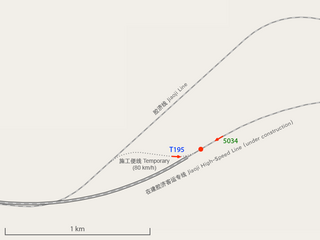The Sutton Coldfield train crash took place at about 16:13 on 23 January 1955 in Sutton Coldfield, Warwickshire, when an express passenger train traveling from York to Bristol, derailed due to excessive speed on a sharp curve.

The Harrow and Wealdstone rail crash was a three-train collision at Harrow and Wealdstone station in Wealdstone, Middlesex during the morning rush hour of 8 October 1952. The crash resulted in 112 deaths and 340 injuries, 88 of these being detained in hospital. It remains the worst peacetime rail crash in British history and the second deadliest overall after the Quintinshill rail disaster of 1915.

Over the latter years of the 19th and early years of the 20th centuries, Penistone in Yorkshire gained a name as an accident black-spot on Britain's railway network; indeed, it could be said to hold the title of the worst accident black-spot in the country. The main line through the town was the Woodhead route of the Manchester, Sheffield and Lincolnshire Railway between Sheffield Victoria and Manchester, London Road. The line was heavily graded with a summit some 400 yards inside the eastern portal of the Woodhead tunnel.
The Sarai Banjara rail disaster occurred on 2 December 2000, when a derailed freight train crossed onto the opposite track early in the morning in Punjab, India. A Howrah–Amritsar Express a passenger train coming from other direction hit the freight train head-on at speed, killing 46 people and injuring at least 150.
The Ealing rail crash was an accident on the British railway system that occurred on 19 December 1973. The 17:18 express train from London Paddington to Oxford—with approximately 650 passengers on board—was derailed while travelling at around 70 mph (110 km/h) between Ealing Broadway and West Ealing. Ten passengers were killed and 94 were injured, and it was Britain's deadliest train crash of the decade until the Moorgate tube crash which killed 45. The cause of the accident was an unsecured maintenance door that had fallen open whilst the train was travelling, after having struck several lineside objects, it struck a points machine at Longfield Avenue, derailing the entire train.

The Thirsk rail crash occurred on 31 July 1967 at Thirsk, Yorkshire, England on the British Rail East Coast Main Line.
There have been a number of train accidents on the railway network of Victoria, Australia. Some of these are listed below.
The railways of New South Wales, Australia have had many incidents and accidents since their formation in 1831. There are close to 1000 names associated with rail-related deaths in NSW on the walls of the Australian Railway Monument in Werris Creek. Those killed were all employees of various NSW railways. The details below include deaths of employees and the general public.
The 2005 Phú Lộc derailment was a crash involving an express passenger train that derailed in central Vietnam on 12 March 2005 when it was running on the North–South Railway, killing 11 people and injuring hundreds, many of which were in a serious condition after the crash. The derailment occurred in Phú Lộc District, Thừa Thiên–Huế Province as the train was traveling from Hanoi to Ho Chi Minh City. The crash was described as "the most tragic rail accident in Vietnam in the past 30 years", and "the country's worst-ever rail accident".

The Zibo train collision was a major train collision that occurred on the morning of April 28, 2008, near the city of Zibo, in Shandong province, People's Republic of China. The collision occurred on the Jiaoji Railway, which links the important cities of Qingdao and Jinan in Shandong province. With a death toll of 72 people and 416 injuries, the collision was the deadliest rail accident in the People's Republic of China since a 1997 accident in Hunan.

The Friedewald train collision was a railway accident on 12 September 2009 in Saxony, Germany. It involved two steam-hauled passenger trains of the narrow gauge heritage Radebeul–Radeburg railway. One hundred and twenty-one people were injured, four of them seriously. Substantial damage was sustained by the locomotives and rolling stock.
The Marden rail crash occurred on 4 January 1969 near Marden, Kent, United Kingdom, when a passenger train ran into the rear of a parcels train, having passed two signals at danger. Four people were killed and 11 were injured. One person was awarded the British Empire Medal for his part in the aftermath of the collision.

The Little Cornard derailment occurred on 17 August 2010 when a passenger train collided with a road vehicle on a level crossing on the Gainsborough Line near Little Cornard, Suffolk, and partly derailed. The vehicle, a tanker lorry, had begun crossing over the track when the Class 156 train from Sudbury destined for Marks Tey struck it whilst travelling at a speed of approximately 40 miles per hour (64 km/h).
The Rometta Marea derailment occurred on Saturday 20 July 2002 in Rometta Marea, part of the Rometta comune in Sicily, Italy.
This is a list of significant railway accidents in Queensland, Australia.
The Çorlu train derailment was a fatal railway accident which occurred in 2018 at the Çorlu district of Tekirdağ Province in northwestern Turkey when a train derailed, killing 24 passengers and injuring 318, including 42 severely.

The Livraga derailment is the only railway accident to date on the Italian high speed rail network. It took place on 6 February 2020 when a high-speed train derailed at Livraga, Lombardy, Italy. Two people died and 31 were injured.

The Ingenheim derailment occurred on 5 March 2020 when a TGV train derailed near Ingenheim, Bas-Rhin, Grand Est, France, on the LGV Est rail line due to a landslip. Twenty-one of the 348 passengers on board were injured, along with the driver.

Napoli Porta Nolana station is the main and terminal station of the Circumvesuviana railways, today managed by the Ente Autonomo Volturno (EAV).









